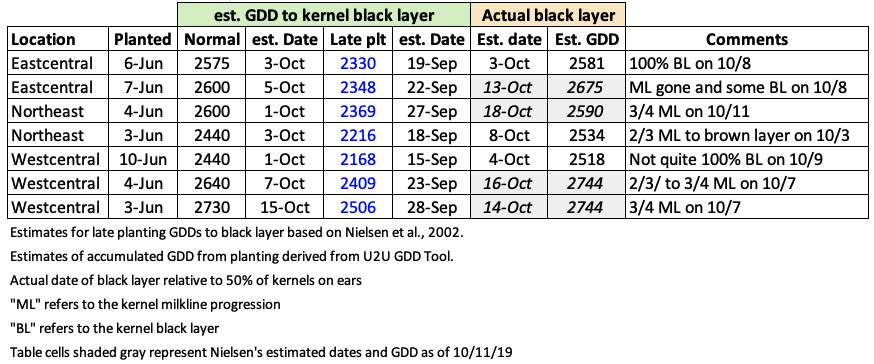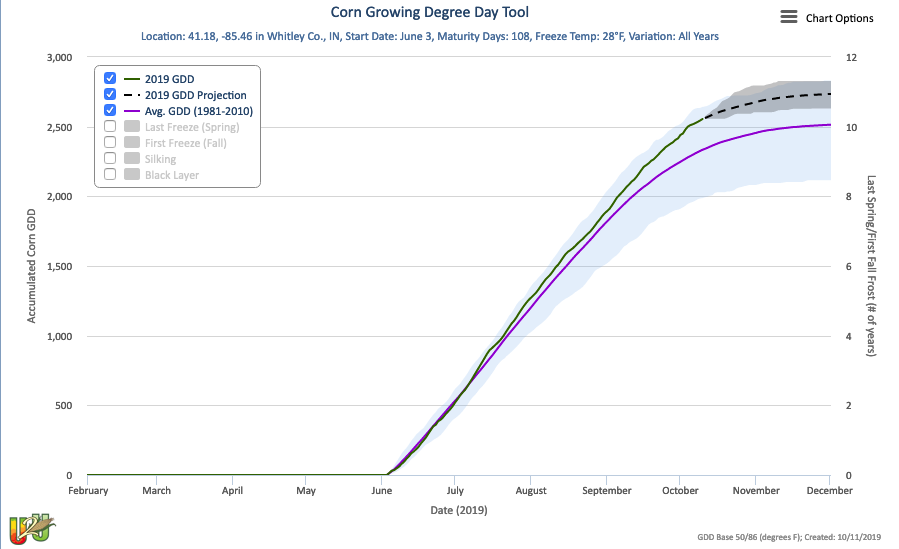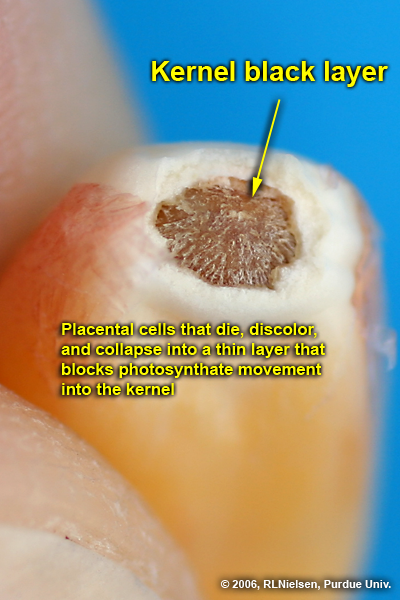12 Oct 2019
URL: http://www.kingcorn.org/news/articles_19/LatePlantedCornMaturity_1012.html
Late Planted Corn Not Maturing as Expected
R.L. (Bob) Nielsen
Agronomy Dept., Purdue Univ.
West Lafayette, IN 47907-2054
Email address: rnielsen at purdue.edu
Twitter: @PurdueCornGuy
In recent weeks, I have received a few reports from farmers and agronomists that some late-planted corn fields are not maturing as expected. Specifically, the number of Growing Degree Days (GDD) from planting to kernel black layer is greater than anticipated relative to the GDD ratings for the hybrids AND the unusually late planting season of 2019. This is interesting because earlier this season, when we were all struggling to find the planting "windows of opportunity", I offered some guidelines for making hybrid maturity decisions for delayed planting predicated on the fact that hybrid GDD to maturity decrease with delayed planting (Nielsen, 2019).
Results from earlier research conducted throughout Indiana and Ohio (Nielsen et al., 2002) indicated that the number of GDD from planting to kernel black layer decrease approximately 6.8 GDD per day of delayed planting after May 1. For example, a hybrid normally rated as 2700 GDD to black layer, but planted on May 31 (30 days after May 1), might reach maturity (kernel black layer) in only 2496 GDD after planting (2700 - (30 days x 6.8) instead of its usual 2700 GDD. The results from that earlier research suggested that farmers could plant their usual relative hybrid maturities later than otherwise expected with minimal risk of late season damage from frost or freezing temperatures.
So, what is going on with the crop this year? Well, it appears that not only are GDD to black layer greater than expected relative to the expected reduction in GDD due to late planting, but, in some fields, are actually greater than the hybrids' rated GDD to maturity under normal planting dates.
Indeed, this unexpected phenomenon is happening in a number of our field scale research trials around the state. The accompanying table highlights seven trials planted between June 3 and June 10 in eastcentral, northeast, and westcentral Indiana in 2019. The trials represent 5 different corn hybrids ranging in relative maturity from 101 to 111 "days". Seed company ratings for GDD to black layer range from 2440 to 2730 for "normal" planting dates. The estimated calendar dates for black layer, based on those GDD and "normal" planting dates, ranged from Oct 1 to Oct 15 (HPRCC, 2019). Based on the results from past research (Nielsen et al., 2002), we expected actual GDD to black layer for each location's late planting date to only range from 2168 to 2506. The estimated calendar dates for black layer, based on GDD adjusted for the late planting dates, ranged from Sep 15 to Sep 28.
Not only did none of the seven trials reach kernel black layer by mid- to late September as predicted by their "late planting" adjusted hybrid GDD, six of the trials have or will reach black layer in more GDD than expected based on their hybrid GDD ratings for "normal" planting dates.

The Big Question Is...
Why are these late planted fields maturing in more GDD than our earlier research predicted?
The answer to that question is not clear, but there is some evidence that kernel black layer development occurs in response to reduced sucrose availability late in the season (Afuakwa et al., 1984) as photosynthesis slows in response to general late-season leaf deterioration (e.g., drought, disease, nutrient deficiency) and/or sub-optimum cooler temperatures typical for September and October prior to frost or killing freeze events. If true, one could turn that fact around and suggest that warmer than normal temperatures during September might encourage higher than normal photosynthetic rates in a late-planted AND still green corn crop. Higher than normal photosynthetic rates, for September, would translate to higher than normal sucrose availability for the immature kernels and, possibly, result in a delay in the development of the kernel black layer.
Indeed, September 2019 was 4 to 7º F warmer than normal statewide across Indiana (Midwest Climate Watch, MRCC). The positive impact of those warm temperatures on GDD accumulations during September was dramatic (Fig. 1, example for Whitley Co, Indiana). That fact, plus the possible relationship between late-season sucrose availability and kernel black layer development, may explain why some late-planted corn fields are maturing later than expected, both in terms of GDD and calendar date.

Fig. 1. Actual, projected, and 30-yr average GDD accumulations from June 3 planting in Whitley Co, Indiana, as of Oct 11, 2019. Source: U2U Corn GDD Tool (HPRCC, 2019)
"It's what you learn after you know it all that counts" ___ John Wooden
For more information...
Afuakwa, J.J., R. Kent Crookston, and R.J. Jones. 1984. Effect of temperature and sucrose availability on kernel black layer development in maize. Crop Sci. 24:285-288.
HPRCC. 2019. U2U Decision Support Tools - Corn GDD. Useful to Usable Project. High Plains Regional Climate Center (HPRCC) https://hprcc.unl.edu/gdd.php [URL accessed Oct 2019].
Nielsen, R.L. (Bob). 2012. Interpreting Corn Hybrid Maturity Ratings. Corny News Network, Purdue Univ. http://www.kingcorn.org/news/timeless/HybridMaturity.html [URL accessed Oct 2019].
Nielsen, R.L. (Bob). 2017. Heat Unit Concepts Related to Corn Development. Corny News Network, Purdue Univ. http://www.kingcorn.org/news/timeless/HeatUnits.html [URL accessed Oct 2019].
Nielsen, R.L. (Bob). 2019. Hybrid Maturity Decisions for Delayed Planting. Corny News Network, Purdue Univ. Extension. http://www.kingcorn.org/news/timeless/HybridMaturityDelayedPlant.html [URL accessed Oct 2019]
Nielsen, Robert L., Peter R. Thomison, Gregory A. Brown, Anthony L. Halter, Jason Wells, and Kirby L. Wuethrich. 2002. Delayed Planting Effects on Flowering and Grain Maturation of Dent Corn. Agron. J. 94:549-558.
END OF DOCUMENT
